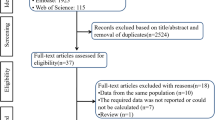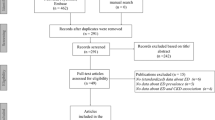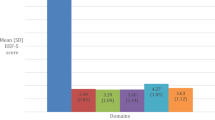Abstract
This review of the current epidemiological literature on erectile dysfunction (ED) suggests that approximately 5–20% of men have moderate-to-severe ED. Different definitions of ED, age distributions and concomitant medical conditions, as well as methodological differences, may explain much of the variance in reported prevalence rates. Various chronic disorders are associated with elevated rates of ED including depression, diabetes, and cardiovascular and neurological diseases. Such disorders are more common in the elderly, which may partially explain the elevated prevalence of ED in men over 60 y of age. Currently, up to 70% of men with ED are not treated. However, so many men experience considerable distress from their condition, that the increasing awareness of ED as well as the availability of noninvasive treatments may result in a greater proportion of patients seeking treatment, and eventually regaining satisfaction with their sex life.
This is a preview of subscription content, access via your institution
Access options
Subscribe to this journal
Receive 8 print issues and online access
$259.00 per year
only $32.38 per issue
Buy this article
- Purchase on Springer Link
- Instant access to full article PDF
Prices may be subject to local taxes which are calculated during checkout
Similar content being viewed by others
References
Lewis R, Hatzichristou D, Lauman E, McKinley J . Epidemiological and natural history of erectile dysfunction; risk factors including iatrogenic and aging. In: Jardin A, Wagner G, Khoury S, Giuliano F, Padma-Nathan H, Rosen R (eds). Erectile Dysfunction. Plymbridge Distributors Ltd, Plymouth PL 6 7PY, United Kingdom, 2000, pp 19–51.
Simons JS, Carey MP . Prevalence of sexual dysfunctions: results from a decade of research. Arch Sex Behav 2001; 30: 177–219.
NIH Consensus Development Panel on Impotence. Impotence. NIH Consensus Development Panel on Impotence. Am Med Assoc 1993; 270: 83–90.
Krane RJ, Goldstein I, Saenz de Tejada I . Impotence. N Engl J Med 1989; 321: 1648–1659.
Fugl-Meyer AR, Branholm IB, Fugl-Meyer KS . Happiness and domain-specific life satisfaction in adult northern Swedes. Clin Rehabili 1991; 5: 25–33.
Fugl-Meyer AR, Lodnert G, Branholm IB, Fugl-Meyer KS . On life satisfaction in male erectile dysfunction. Int J Impot Res 1997; 9: 141–148.
Fugl-Meyer KS . Chapter 12 Sex in Sweden: On the Swedish Sexual Life. The National Institute of Public Health. Stockholm, 1998, pp 218–234.
Fendrick AM . Access to innovative treatment of erectile dysfunction: clinical, economic, and quality-of-life considerations. Am J Manage Care 2000; 6 (Suppl 12): S632–S638.
Tan HL . Economic cost of male erectile dysfunction using a decision analytic model: for a hypothetical managed-care plan of 100,000 members. Pharmacoeconomics 2000; 17: 77–107.
Stolk EA et al. Cost utility analysis of sildenafil compared with papaverine–phentolamine injections. BMJ 2000; 320: 1165–1168.
Smith KJ, Roberts MS . The cost-effectiveness of sildenafil. Ann Intern Med 2000; 132: 933–937.
Kinsey AC . Sexual Behaviour in the Human Male. W B Saunders: Philadelphia, 1948.
Spector IP, Carey MP . Incidence and prevalence of the sexual dysfunctions: a critical review of the empirical literature. Arch Sex Behav 1990; 19: 389–408.
Feldman HA et al. Impotence and its medical and psychosocial correlates: results of the Massachusetts Male Aging Study. J Urol 1994; 151: 54–61.
Rosen RC et al. The international index of erectile function (IIEF): a multidimensional scale for assessments of erectile dysfunction. Urology 1997; 49: 822–830.
Fugl-Meyer AR, Fugl-Meyer K . Sexual disabilities, problems and satisfaction in 18–74 year old Swedes. Scand J Sexol 1999; 2: 79–105.
Béjin A . The epidemiology of premature ejaculation and of its association with erectile dysfunction. Adrologie 1999; 9: 211–225.
Solstad K, Hertoft P . Frequency of sexual problems and sexual dysfunction in middle-aged Danish men. Arch Sex Behav 1993; 22: 51–58.
Johannes CB et al. Incidence of erectile dysfunction in men 40 to 69 years old: longitudinal results from the Massachusetts male aging study. J Urol 2000; 163: 460–463.
Ventegodt S . Sex and the quality of life in Denmark. Arch Sex Behav 1998; 27: 295–307.
Kontula O, Haavio-Mannila E . Sexual Pleasures. Enhancement of Sex Life in Finland, 1971–1992. Dartmouth Publishing Company: Aldershot, 1995.
Malmsten UG, Milson I, Molander U, Norlen LJ . Urinary incontinence and lower urinary tract symptoms: an epidemiological study of men aged 45 to 99 years. J Urol 1997; 158: 1733–1737.
Braun M et al. Epidemiology of erectile dysfunction: results of the ‘Cologne Male Survey’. Int J Impot Res 2000; 12: 305–311.
Braun M et al. KEED-erster deutschspraching validierter Fragebogen zur Erfassung der männlichen sexuallen Funktion. Aktuel Urol 1998; 29: 300–305.
Meuleman EJ et al. Erectile dysfunction: prevalence and effect on the quality of life; Boxmeer study. Neder Tijdschr Geneesk 2001; 145: 576–581.
O'Leary MP et al. A brief sexual function inventory for urology. Urology 1995; 46: 697–706.
Blanker MH et al. Erectile and ejaculatory dysfunction in a community-based sample of men 50 to 78 years old: prevalence, concern, and relation to sexual activity. Urology 2001; 57: 763–768.
Virag R, Beck-Ardilly L . Nosology, epidemiology, clinical quantification of erectile dysfunction. La Revue Med Interne 1997; 18 (Suppl 1): 10s–13s.
Martin-Morales A et al. Prevalence and independent risk factors for ereticle dysfunction in Spain: results of the Epidemiologia de la Disfuncion Erectil Masculina Study. J Urol 2001; 166: 569–575.
Panser LA et al. Sexual function of men aged 40 to 79 years: the Olmsted County Study of urinary symptoms and health status among men. J Am Geriatri Soc 1995; 43: 1107–1111.
Laumann EO, Paik A, Rosen RC . Sexual dysfunction in the United States: prevalence and predictors. JAMA 1999; 281: 537–544.
Pinnock CB, Stapleton AM, Marshall VR . Erectile dysfunction in the community: a prevalence study. Med J Austr 1999; 171: 353–357.
Ergen A et al. Prevalence and correlates of erectile dysfunction in Turkey. A population-based study. Poster presented at the ESIR Congress, 2001.
Feldman HA et al. Erectile dysfunction and coronary risk factors: prospective results from the Massachusetts male aging study. Prev Med 2000; 30: 328–338.
Wabrek AJ, Burchell RC . Male sexual dysfunction associated with coronary heart disease. Arch Sex Behav 1980; 9: 69–75.
Sjögren K, Fugl-Meyer AR . Some factors influencing quality of sexual life after myocardial infarction. Int Rehabil Med 1983; 5: 197–201.
Diokno AC, Brown MB, Herzog AR . Sexual function in the elderly. Arch Intern Med 1990; 150: 197–200.
Wei M et al. Total cholesterol and high density lipoprotein cholesterol as important predictors of erectile dysfunction. Am J Epidemiol 1994; 140: 930–937.
Virag R, Bouilly P, Frydman D . Is impotence an arterial disorder? A study of arterial risk factors in 440 impotent men. Lancet 1985; 1: 181–184.
Bruckert E, Giral P, Heshmati HM, Turpin G . Men treated with hypolipidaemic drugs complain more frequently of erectile dysfunction. J Clin Pharm Ther 1996; 21: 89–94.
Weinhardt LS, Carey MP . Prevalence of erectile disorder among men with diabetes mellitus: comprehensive review, methodological critique, and suggestions for future research. J Sex Res 1996; 33: 205–214.
Fedele D et al. Erectile dysfunction in diabetic subjects in Italy. Diabetes Care 1998; 21: 1973–1977.
Lundberg PO et al. Neurosexology. Eur J Neurol 2001; 8 (Suppl 3): 2–24.
Fugl-Meyer AR, Fugl-Meyer KS, Lundberg PO . Sexual rehabilitation. In: Frommelt P. Grötzbach (eds). Neurorehabilitation. Blackwell: Oxford, 1999, pp 370–388.
Elliott M, Biever LS . Head injury and sexual dysfunction. Brain Injury 1996; 10: 703–717.
Lundberg PO et al. Neurological disorders: erectile and ejaculatory dysfunction. In: Jardin A, Wagner G, Khoury S et al (eds). Erectile Dysfunction. 1999, pp 591–646.
Araujo AB et al. The relationship between depressive symptoms and male erectile dysfunction: cross-sectional results from the Massachusetts Male Aging Study. Psychosom Med 1998; 60: 458–465.
Mitchell JE, Popkin MK . Antidepressant drug therapy and sexual dysfunction in men: a review. J Clin Psychopharmacol 1983; 3: 76–79.
Stanford JL et al. Urinary and sexual function after radical prostatectomy for clinically localized prostate cancer: the Prostate Cancer Outcomes Study. JAMA 2000; 283: 354–360.
Catalona WJ, Carvalhal GF, Mager DE, Smith DS . Potency, continence and complication rates in 1,870 consecutive radical retropubic prostatectomies. J Urol 1999; 162: 433–438.
Siegel T et al. The development of erectile dysfunction in men treated for prostate cancer. J Urol 2001; 165: 430–435.
Leliefeld HHJ, Stoevelaar HJ, McDonnell J . Sexual function before and after various treatments for symptomatic benign prostatic hyperplasia. BJU Int 2002; 89: 208–213.
Kunelius P, Häkkinen J, Lukkarinen O . Sexual functions in patients with benign prostatic hyperplasia before and after transurethral resection of the prostate. Urology Res 1998; 26: 7–9.
Francisca EAE et al. Sexual function following high energy microwave thermotherapy: results of a randomized controlled study comparing transurethral microwave thermotherapy to transurethral prostatic resection. J Urol 1999; 161: 486–490.
Mutscher R et al. Transurethral water-induced thermotherapy for the treatment of benign prostatic hyperplasia: a prospective multicenter clinical trial. J Urol 2000; 164: 1565–1569.
Slag MF et al. Impotence in medical clinic outpatients. JAMA 1983; 249: 1736–1740.
O'Keefe M, Hunt DK . Assessment and treatment of impotence. Med Clini North Am 1995; 79: 415–434.
Derby CA, Barbour MM, Hume AL, McKinlay JB . Drug therapy and prevalence of erectile dysfunction in the Massachusetts Male Aging Study cohort. Pharmacotherapy 2001; 21: 676–683.
Benet AE, Melman A . The epidemiology of erectile dysfunction. Urol Clini North Am 1995; 22: 699–709.
Kim YC et al. Endocrine and metabolic aspect in including treatment. In: Jardin A, Wagner G, Khoury S et al. (eds). Erectile Dysfunction, Plymbridge Distributor Ltd, Plymouth, United Kingdom, 1999; pp 205–240.
Rhoden EL et al. Is there any relation between serum levels of total testosterone and the severity of erectile dysfunction? Int J Impot Res 2002; 14: 167–171.
Diagnostic and Statistical Manual of Mental Disorders. Washington, DC: American Psychiatric Association, 1994.
Fugl-Meyer KS, Fugl-Meyer AR . Sexual dysfunctions are not singularities. Int J Impot Res 2002. (Submitted).
Morales A, Choi H, Giami A et al. Socio-cultural, educational and ethical aspects of erectile dysfunction. In: Jardin A, Wagner G, Khoury S et al. (eds). Erectile Dysfunction, Plymbridge Distributor Ltd, Plymouth, United Kingdom, 1999; pp 575–590.
Ansong KS, Lewis C, Jenkins P, Bell J . Help-seeking decisions among men with impotence. Urology 1998; 52: 834–837.
Chew KK et al. Erectile dysfunction in general medicine practice: prevalence and clinical correlates. Int J Impot Res 2000; 12: 41–45.
Alonso Sandoica E et al. Impotence in diabetics: its prevalence and social-health implications. Atención Primaria 1997; 20: 435–439.
Skaer TL, Sclar DA, Robinson LM, Galin RS . Trends in the rate of self-report and diagnosis of ereticle dysfunction in the United States 1990–1998. Dis Manage Health Outcomes 2001; 9: 33–41.
Acknowledgements
This review was supported by a nonrestricted grant from Bayer AG.
Author information
Authors and Affiliations
Corresponding author
Rights and permissions
About this article
Cite this article
Kubin, M., Wagner, G. & Fugl-Meyer, A. Epidemiology of erectile dysfunction. Int J Impot Res 15, 63–71 (2003). https://doi.org/10.1038/sj.ijir.3900949
Received:
Revised:
Accepted:
Published:
Issue Date:
DOI: https://doi.org/10.1038/sj.ijir.3900949
Keywords
This article is cited by
-
AI Tools for Assessing Human Fertility Using Risk Factors: A State-of-the-Art Review
Journal of Medical Systems (2023)
-
Short-term intracavernous self-injection treatment of psychogenic erectile dysfunction secondary to sexual performance anxiety in unconsummated marriages
International Journal of Impotence Research (2022)
-
I disordini endocrini nella pratica clinica: epidemiologia e domanda di salute nella vita reale
L'Endocrinologo (2021)
-
Socioeconomic status and barriers for contacting the general practitioner when bothered by erectile dysfunction: a population-based cross-sectional study
BMC Family Practice (2020)
-
Infrapubic approach for placement of inflatable penile prosthesis: contemporary review of technique and implications
International Journal of Impotence Research (2020)



